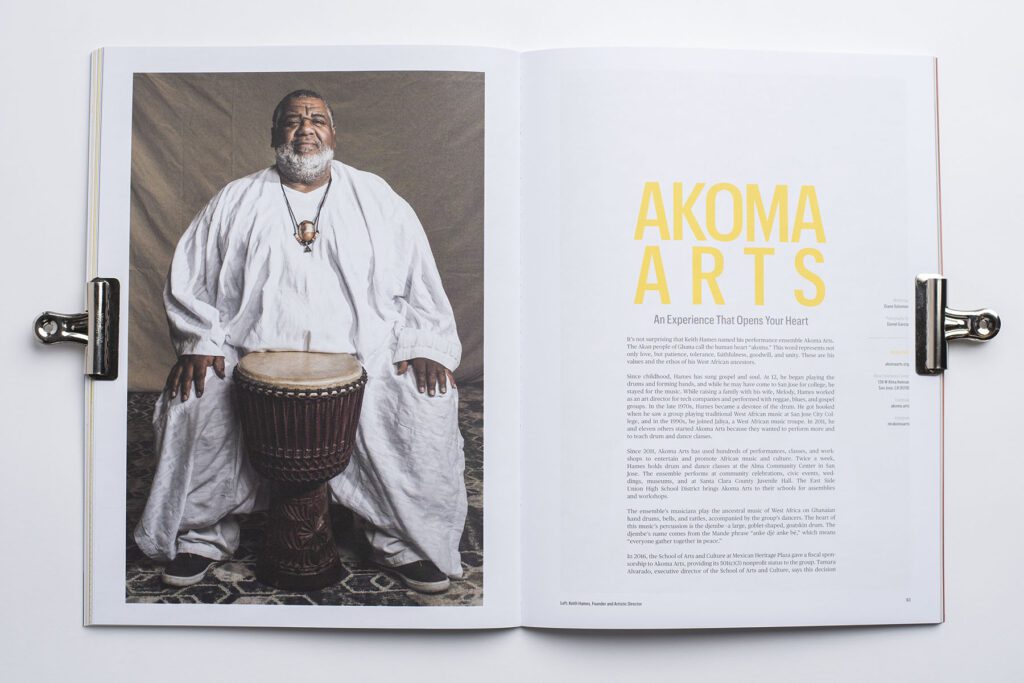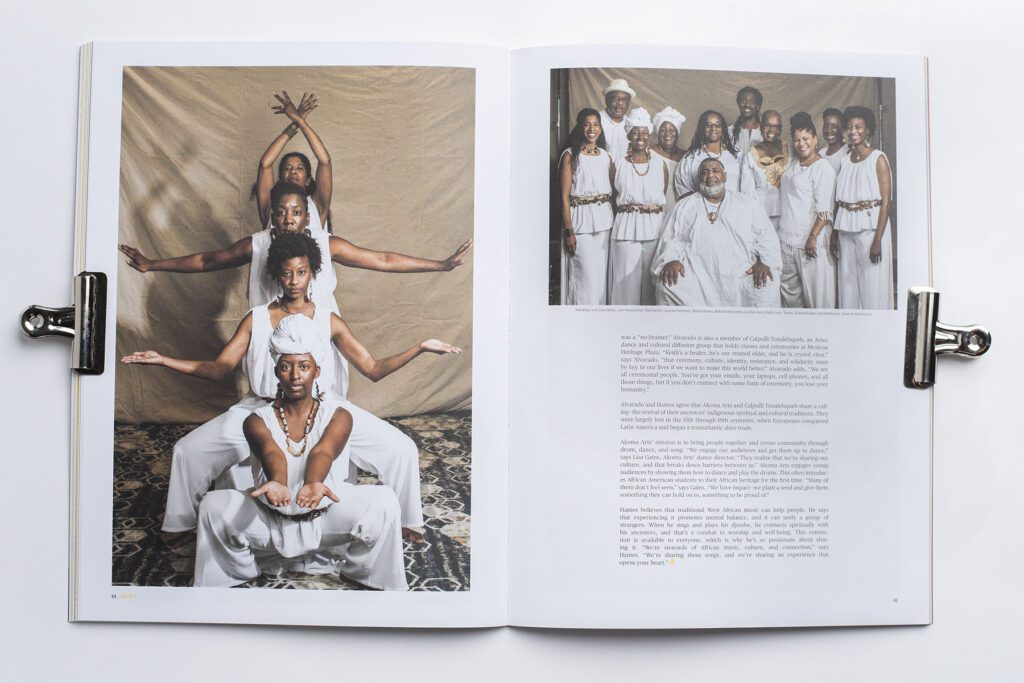An Experience That Opens Your Heart

It’s not surprising that Keith Hames named his performance ensemble Akoma Arts. The Akan people of Ghana call the human heart “akoma.” This word represents not only love, but patience, tolerance, faithfulness, goodwill, and unity. These are his values and the ethos of his West African ancestors.
Since childhood, Hames has sung gospel and soul. At 12, he began playing the drums and forming bands, and while he may have come to San Jose for college, he stayed for the music. While raising a family with his wife, Melody, Hames worked as an art director for tech companies and performed with reggae, blues, and gospel groups. In the late 1970s, Hames became a devotee of the drum. He got hooked when he saw a group playing traditional West African music at San Jose City College, and in the 1990s, he joined Jaliya, a West African music troupe. In 2011, he and eleven others started Akoma Arts because they wanted to perform more and teach drum and dance classes.
Since 2011, Akoma Arts has used hundreds of performances, classes, and workshops to entertain and promote African music and culture. Twice a week, Hames holds drum and dance classes at the Alma Community Center in San Jose. The ensemble performs at community celebrations, civic events, weddings, museums, and at Santa Clara County Juvenile Hall. The East Side Union High School District brings Akoma Arts to their schools for assemblies and workshops.
The ensemble’s musicians play the ancestral music of West Africa on Ghanaian hand drums, bells, and rattles, accompanied by the group’s dancers. The heart of this music’s percussion is the djembe—a large, goblet-shaped, goatskin drum. The djembe’s name comes from the Mande phrase “anke djé anke bé,” which means “everyone gathers together in peace.”

In 2016, the School of Arts and Culture at Mexican Heritage Plaza gave a fiscal sponsorship to Akoma Arts, providing its 501(c)(3) nonprofit status to the group. Tamara Alvarado, executive director of the School of Arts and Culture, says this decision was a “no-brainer.” Alvarado is also a member of Calpulli Tonalehqueh, an Aztec dance and cultural diffusion group that holds classes and ceremonies at Mexican Heritage Plaza. “Keith’s a healer, he’s our trusted elder, and he is crystal clear,” says Alvarado, “that ceremony, culture, identity, resistance, and solidarity must be key in our lives if we want to make this world better.” Alvarado adds, “We are all ceremonial people. You’ve got your emails, your laptops, cell phones, and all those things, but if you don’t connect with some form of ceremony, you lose your humanity.”
Alvarado and Hames agree that Akoma Arts and Calpulli Tonalehqueh share a calling—the revival of their ancestors’ indigenous spiritual and cultural traditions. They were largely lost in the 15th through 19th centuries, when Europeans conquered Latin America and began a transatlantic slave trade.
Akoma Arts’ mission is to bring people together and create community through drum, dance, and song. “We engage our audiences and get them up to dance,” says Lisa Gains, Akoma Arts’ dance director. “They realize that we’re sharing our culture, and that breaks down barriers between us.” Akoma Arts engages young audiences by showing them how to dance and play the drums. This often introduc-es African American students to their African heritage for the first time. “Many of them don’t feel seen,” says Gains. “We have impact—we plant a seed and give them something they can hold on to, something to be proud of.”
Hames believes that traditional West African music can help people. He says that experiencing it promotes mental balance and can unify a group of strangers. When he sings and plays his djembe, he connects spiritually with his ancestors, and that’s a conduit to worship and well-being. This connection is available to everyone, which is why he’s so passionate about sharing it. “We’re stewards of African music, culture, and connection,” says Hames. “We’re sharing these songs, and we’re sharing an experience that opens your heart.”
The article originally appeared in issue 10.2, “Sight and Sound,” 2018.

